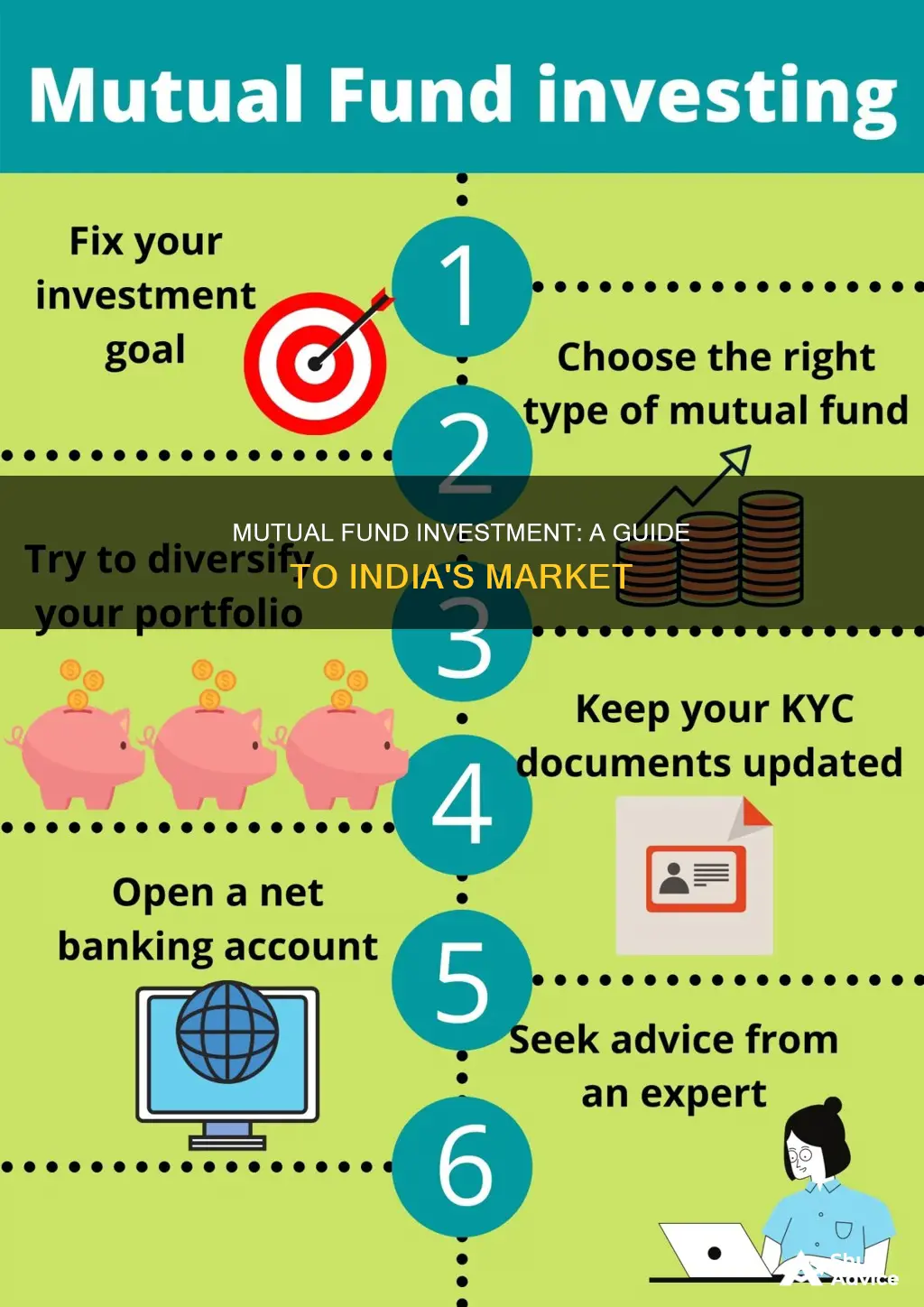
Mutual funds are a type of investment vehicle that pools money from investors with shared financial objectives. This money is then used to invest in multiple assets, such as stocks, bonds, and other financial instruments. The fund's investments are made by an 'asset management company' (AMC) and managed by a professional fund manager. The manager's role is to research and monitor the market, deciding which stocks to buy, sell or hold, with the aim of generating maximum returns.
In India, mutual funds are regulated by the Securities and Exchange Board of India (SEBI), which ensures that fees charged by mutual funds are subject to specified limits. With a variety of schemes to choose from, mutual funds are a popular investment choice for those who lack the time or inclination to research the market but want to grow their wealth.
| Characteristics | Values |
|---|---|
| Definition | An investment vehicle that pools money from various investors and uses the money to invest in the stock market. |
| Types | Equity (stocks), fixed income (bonds), money market funds (short-term debt), or a combination of both stocks and bonds (balanced or hybrid). |
| Investment Objective | The investment objective of a mutual fund determines what type of securities the pooled money is invested in. For example, if a mutual fund’s focus is to generate long-term wealth, the fund’s investments would predominantly include stocks of huge, stable corporations. |
| Structure | Open-ended, debt funds, money market mutual funds, commodity mutual funds, hybrid mutual funds, tax saving mutual funds, and asset allocation funds. |
| Investment Options | Lump sum or Systematic Investment Plan (SIP). |
| Benefits | Affordability, diversification, professional management, tax saving, convenience, and ease. |
| Risks | Macroeconomic risks, liquidity risk, credit risk, interest rate risk, and investor biases. |
What You'll Learn

How mutual funds work in India
Mutual funds in India work by pooling money from investors and using it to invest in securities such as stocks, bonds, and government securities. The fund manager decides on a portfolio of investments based on the fund's strategy, with the aim of maximising returns for investors.
Step 1: New Fund Offer (NFO)
Investors get the opportunity to subscribe to a mutual fund scheme during its initial offer period. The fund's strategy is disclosed at this stage, and it remains fixed thereafter. NFO subscriptions are usually cheaper than investing in existing funds. However, investors need to consider factors such as the fund house's reputation, investment objectives, costs, risks, minimum subscription amount, and investment tenure before investing in an NFO.
Step 2: Pooling Money from Investors
Mutual funds pool money from many small investors, allowing them to invest in large portfolios that would otherwise be out of their reach. Investors can choose to invest a lump sum or through a Systematic Investment Plan (SIP), where a fixed amount is invested regularly.
Step 3: Investing in Securities
The pooled money is then invested in securities like shares, bonds, and government securities. The fund manager, who is an expert in financial markets, selects the securities based on the fund's strategy and their potential to maximise returns. The fund manager continuously monitors the performance of the selected securities and may replace them if they are underperforming.
Step 4: Distributing Returns
Once the fund earns returns, they are either distributed to investors as dividends or reinvested into the fund to enhance its value. This completes the cycle of mutual fund investing.
Structure of Mutual Funds in India
According to the Securities and Exchange Board of India (SEBI) regulations, there are three key entities involved in setting up and managing a mutual fund in India:
- Sponsor: The person or organisation that creates the fund and is responsible for obtaining approvals from SEBI.
- Trust and Trustees: A public trust is formed by the sponsor, which then appoints trustees to manage the trust and set up an Asset Management Company (AMC) to manage the fund.
- Asset Management Company (AMC): The AMC hires the fund manager and introduces various investment schemes based on the financial requirements of investors.
Mutual Funds: High Fees, Worth the Investment?
You may want to see also

Types of mutual funds
Mutual funds are a popular investment vehicle in India, offering investors a comprehensive, flexible, and hassle-free mode of investment. The choice of a mutual fund should be based on one's investment goals and risk tolerance. Here is an overview of the different types of mutual funds available in India:
- Based on Structure:
- Open-ended funds: Investors can buy or sell units at any time, with no fixed maturity date. These funds offer high liquidity and are ideal for those seeking flexibility.
- Closed-ended funds: These have a fixed number of units and a stipulated maturity period. Investments are limited to the initial launch period, and redemptions occur only at maturity. Closed-ended funds are often listed on stock exchanges to enhance liquidity.
- Interval funds: Combining features of open-ended and closed-ended funds, interval funds allow transactions at specific intervals during the fund's tenure. They provide periodic liquidity while retaining characteristics of closed-ended funds.
- Based on Asset Class:
- Equity funds: Investing primarily in company shares, these funds offer high potential returns but carry higher risk. They are ideal for long-term investors with a high-risk tolerance and include categories like Large-Cap, Mid-Cap, and Small-Cap funds.
- Debt funds: These funds invest in fixed-income securities, such as corporate bonds and government securities, offering stability and regular income with lower risk. Types include low-duration, liquid, and credit risk funds.
- Hybrid funds: Balancing risk and return, hybrid funds mix debt and equity investments. They can have fixed or flexible allocation ratios and include balanced funds, aggressive funds, and multi-asset allocation funds.
- Based on Investment Objective:
- Growth funds: Focusing on high-growth stocks, these funds aim for capital appreciation over the long term. They are suitable for investors seeking substantial returns and able to tolerate higher risk and volatility.
- Tax-saving funds (ELSS): With a lock-in period of three years, these funds invest primarily in equities and offer tax benefits under Section 80C of the Income Tax Act.
- Liquidity-based funds: Categorised by their liquidity, including ultra-short-term and liquid funds for short-term investments, and retirement funds and long-term fixed-income funds for long-term financial goals.
- Capital protection funds: Aiming to preserve capital, these funds allocate a portion to fixed-income securities while also investing in equities.
- Fixed-maturity funds (FMF): FMFs invest in fixed-income securities that align with the fund's maturity period, offering predictable returns for specific financial goals.
- Pension funds: Designed to provide a steady income during retirement, these funds often have a long investment horizon and may invest in a mix of equities and bonds.
- Based on Specialty:
- Sectoral/thematic funds: Investing in specific sectors or themes, such as technology or healthcare.
- Index funds: Replicating the performance of a particular index by investing in the same securities.
- Fund of funds (FoF): Investing in other mutual funds, both domestic and international, to reduce risk by diversifying across multiple funds.
- Emerging market funds: Focusing on companies in developing countries with high growth potential but also higher political and economic risks.
- Global funds: Investing in companies worldwide, including the investor's home country, for diversified international exposure.
- Real estate funds: Investing in companies operating in the real estate sector, such as developers and property managers.
- Commodity-focused stock funds: Investing in companies involved in commodity production, such as mining or agriculture.
- Market-neutral funds: Aiming for stable returns by investing in securities like treasury bills and ETFs without direct market exposure, minimising market risk.
- Inverse/leveraged funds: Generating returns by betting against market trends, using derivatives and other strategies. These funds are high-risk and suitable for experienced investors only.
- Based on Risk:
- Low-risk funds: Investing mainly in government securities, offering stability and lower returns.
- Very-low-risk funds: Ideal for short-term goals, including liquid funds and ultra-short-term funds with high liquidity and minimal market exposure.
- Medium-risk funds: Balancing risk and reward, often investing in a mix of equities and debt instruments, suitable for long-term wealth accumulation.
- High-risk funds: Including inverse mutual funds and those with heavy equity exposure, offering the potential for high returns but also increased volatility and the possibility of large losses.
A Guide to Investing in HDFC Small Cap Fund
You may want to see also

How to invest in mutual funds
There are several ways to start investing in mutual funds. Here are the steps you can follow:
Decide how you want to invest
You can invest in mutual funds through a variety of channels, including:
- A mutual fund distributor: Engage an AMFI-registered distributor for financial advice and transactions, with no direct fees charged to investors.
- Direct investment with an Asset Management Company (AMC): Invest directly with an AMC via office visits or online portals. For new investors, submitting KYC documents is necessary. Direct plans offer higher returns but are more suitable for experienced investors.
- Registered Investment Advisors (RIAs): Opt for SEBI-registered advisors to access direct plans without AMC commissions. RIAs may charge fees and can provide unbiased advice.
- Registrars and Transfer Agents (RTAs): RTAs handle mutual fund transactions for fund houses, allowing investors to streamline multiple investments.
- Online mutual fund investment: Invest through AMC or RTA portals, or distributor websites.
- Stockbrokers: Leverage stockbrokers offering online trading and demat services, who typically provide regular plans.
- Bank-enabled mutual fund investment: Explore wealth management services offered by banks, who typically facilitate regular plans.
- Mutual fund investment via mobile apps: Access mutual fund transactions through mobile apps provided by AMCs or RTAs and perform various transactions with ease.
Choose the type of mutual fund
Mutual funds can be broadly categorized into three types based on distinct asset classes:
- Equity mutual funds: These funds invest in equity and equity-related securities, with the primary objective of capital appreciation. Each type carries a unique risk-return profile, so it's important to select the right fit for your financial goals and risk tolerance.
- Debt mutual funds: These funds invest in debt and money market instruments, focusing on generating income. Categories are based on maturity or duration, such as overnight, liquid, ultra-short duration, and more.
- Hybrid mutual funds: These funds diversify across multiple asset classes like equity, fixed income, gold, or real estate investment trusts. They aim to provide both capital appreciation and income, offering the advantage of asset allocation and spreading investment risk.
Complete the Know Your Customer (KYC) process
Before investing in a mutual fund scheme, whether through online or offline mode, individuals must fill out a KYC form and provide documents to establish their identity and address. This is a mandatory process under the Prevention of Money Laundering Act, 2002, and its associated rules.
Determine your investment budget
Consider your financial goals, risk tolerance, investment horizon, and current financial situation to decide how much you want to invest in mutual funds. There is no legal minimum amount, but each mutual fund in India usually sets its own minimum investment requirement, typically ranging from Rs. 500 to Rs. 5,000.
Understand the costs and fees
When investing in mutual funds, there are various costs to consider, such as management fees, exit loads, broker commissions, transaction charges, selling costs, securities transaction tax (STT), and stamp duty. Be sure to factor in these expenses when making your investment decisions.
Choose a specific mutual fund
Research and select a mutual fund that aligns with your financial goals, risk tolerance, and investment amount. Consider factors like asset allocation, past performance, and the fund's investment objectives.
Start investing
You can choose to invest in mutual funds through a lump sum investment or a Systematic Investment Plan (SIP). With a lump sum investment, you put a larger sum of money into a fund all at once. On the other hand, a SIP allows you to invest a smaller amount regularly (monthly, quarterly, etc.) through auto-debit from your bank account.
Monitor and manage your portfolio
Regularly review the performance of your mutual fund investments and consider rebalancing your portfolio to maintain your desired asset allocation. Remember that mutual fund investing is a continuous process, and you may need to make adjustments over time.
Understanding Governmental Accounting for Investment Trust Funds
You may want to see also

Benefits of investing in mutual funds
Investing in mutual funds offers a multitude of benefits. Here are some of the most important advantages:
Professional Management
Mutual funds are managed by full-time, professional money managers who have the expertise, experience, and resources to actively buy, sell, and monitor investments. This is especially beneficial for investors who don't have the time or knowledge to conduct their own research and purchase individual stocks or bonds. The fund manager continuously monitors investments and rebalances the portfolio to meet the scheme's objectives.
Risk Diversification
Mutual funds provide an easy way to diversify your investments across many securities and asset categories, such as equity, debt, and gold. This helps to spread the risk, so you're not dependent on the performance of a single investment. Even if one investment in the portfolio decreases in value, others may not be impacted and can balance out the losses.
Affordability and Convenience
Mutual funds have low minimum initial investments, making them more affordable for many investors. They are also convenient, as they can be purchased with a single click or through a Systematic Investment Plan (SIP), which helps investors cultivate the habit of investing periodically.
Liquidity
Mutual funds, especially open-ended schemes, offer high liquidity. Investors can easily redeem their units on any business day to meet their financial needs, and the redemption amount is typically credited to their bank account within a few days.
Low Cost
Mutual funds benefit from economies of scale, resulting in a low expense ratio. Operating expenses, such as administration, management, and advertising costs, are shared across a large number of investors, keeping costs low for individual investors.
Tax Benefits
In India, investments in certain types of mutual funds, such as Equity Linked Savings Schemes (ELSS), offer tax benefits under Section 80C of the Income Tax Act. ELSS funds have a short lock-in period of three years and are considered one of the best tax-saving instruments.
Well-Regulated
Mutual funds in India are regulated by the Securities and Exchange Board of India (SEBI), which has laid down stringent rules and regulations to protect investors, ensure transparency, and maintain a fair valuation framework.
Overall, mutual funds offer a simple, convenient, and affordable way to invest, providing access to a diversified portfolio of assets managed by professional experts.
Jollibee's Mutual Fund Investment Guide for Beginners
You may want to see also

Risks of investing in mutual funds
Investing in mutual funds carries a variety of risks, which can be broadly categorised into systematic and unsystematic risk. Here are some of the risks associated with mutual funds:
Market Risk
Market risk, also known as systematic risk, is the possibility of losses due to poor market performance. A variety of factors influence the market, such as natural disasters, inflation, recession, political unrest, and fluctuations in interest rates. Diversifying your portfolio will not help in these scenarios, and investors will have to wait for things to improve.
Concentration Risk
Concentration risk refers to investing heavily in one particular scheme or sector. While profits can be high, losses can be significant as well. Diversifying your portfolio is the best way to minimise this risk.
Interest Rate Risk
Interest rate risk arises from changes in interest rates during the investment period, which may result in a reduction in the price of securities. For example, if you invest Rs.100 at a 5% interest rate for a certain period, and the interest rate increases to 6%, you will no longer be able to get back the Rs.100 you invested as the rate is fixed. The only option is to reduce the market value of the bond.
Liquidity Risk
Liquidity risk refers to the difficulty of redeeming an investment without incurring a loss in the value of the instrument. Mutual funds with long-term and rigid lock-in periods, such as ELSS, often come with liquidity risk. In the case of exchange-traded funds (ETFs), a lack of buyers in the market might make it challenging to redeem investments when needed.
Credit Risk
Credit risk is the possibility that the issuer of the scheme fails to pay the promised interest. In debt funds, fund managers usually include investment-grade securities with high credit ratings, but they may also include lower credit-rated securities to enhance returns, thus increasing credit risk.
Inflation Risk
Inflation risk is the possibility of losing purchasing power due to rising inflation rates. Investors are exposed to this risk when the rate of returns on their investments fails to keep up with inflation. For example, if the rate of returns is 5% and the inflation rate is 3%, investors are left with only 2% in returns.
Exchange Rate Risk
Exchange rate risk is the fear that a decrease in the exchange rate will reduce investment returns. When the value of foreign currency-denominated funds increases, it is believed to result in a decrease in foreign currency, which will lower the rate of returns when exchanged into Indian rupees (INR).
Reinvestment Risk
Regular reinvestments are often accompanied by the risk of losing out on growth opportunities in investments.
Macroeconomic Risks
Macroeconomic risks affect the entire economy and can cause losses for mutual funds. For example, an oil shortage could cause commodity prices to rise, affecting companies that the fund has invested in.
Investor Biases
Investor biases refer to any pre-existing bias that may lead investors to make mistaken investment decisions, such as buying or selling at the wrong time or investing incorrectly due to behavioural reasons.
Unlocking Hedge Fund Investment in South Africa
You may want to see also
Frequently asked questions
A mutual fund is an investment vehicle that pools money from investors with common financial objectives. The money is then invested in multiple assets, such as stocks, bonds, and other financial instruments, in line with the fund's stated objective.
Mutual funds in India pool money from many small investors and invest in securities like shares, bonds, and government securities. The fund manager decides on the portfolio based on the fund's strategy, and investors receive a share in the form of units. When the fund earns returns, they are distributed to investors in proportion to their investment.
Mutual funds offer several benefits, including affordability, diversification, professional management, tax savings, convenience, and the potential for benchmark-beating returns. They are also ideal for investors who lack the time or inclination to research the market but want to grow their wealth.
Mutual funds can be categorised as open-ended or closed-ended, and actively managed or passively managed. Open-ended funds allow investors to subscribe and redeem units at any time, while closed-ended funds have a specified tenor and fixed maturity date. Actively managed funds have fund managers who actively research and monitor the portfolio, while passively managed funds simply replicate a market index.
In India, mutual funds can be purchased directly from Asset Management Companies (AMCs) or through brokers and online investment platforms. Investors can choose to invest a lump sum or opt for a Systematic Investment Plan (SIP), which allows regular investments of smaller amounts at fixed intervals.







